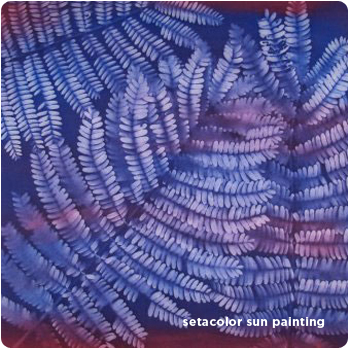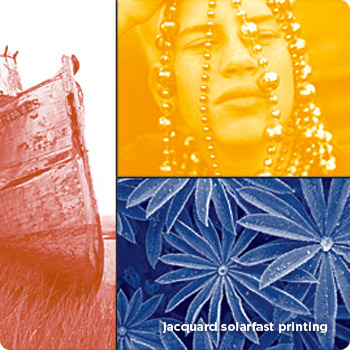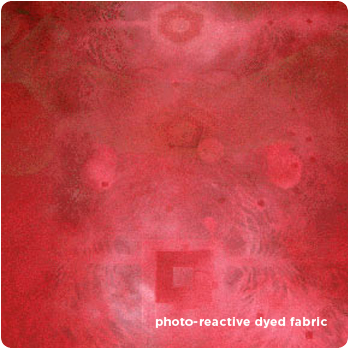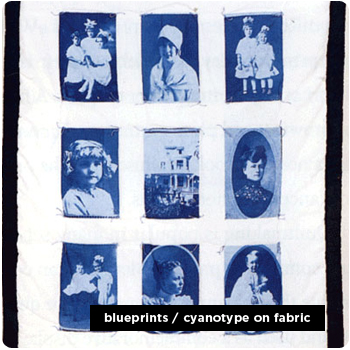
Also called Heliographic Art by some, sun painting or printing utilizes either the radiant infrared or the ultra-violet rays of the sun to create images on fabric. It works because the paint or the dye you are using reacts to the sun in some way. There are three different products we carry that can utilize the rays of the sun to produce art on fabric or clothing. They can be fun and educational, and can produce great fabrics for quilting, conversational t-shirts and many other uses. Great for taking advantage of the sunny days ahead!
 This kind of sun painting is a fantastic activity to do with kids or groups of people, and is easy for beginners. You use a non-toxic water based fabric paint, like Setacolor Transparent for Light Fabrics (thinned with water) or Setasilk or Dynaflow, to make great textural patterns or shapes on the fabric. You can use found objects like leaves, ferns, feathers, & branches, or lace, cutouts, even stencils. Basically, you apply the paint with big foam brushes to the fabric or garment, and while it is still very wet, you put it out in the sun with your objects carefully placed flat on the wet fabric. As the fabric dries in the sun, it becomes darker where the sun hits, and much lighter underneath the objects, leaving a "ghost" shape of the objects you used on the fabric. When you heat set the paint, the designs are permanent.
This kind of sun painting is a fantastic activity to do with kids or groups of people, and is easy for beginners. You use a non-toxic water based fabric paint, like Setacolor Transparent for Light Fabrics (thinned with water) or Setasilk or Dynaflow, to make great textural patterns or shapes on the fabric. You can use found objects like leaves, ferns, feathers, & branches, or lace, cutouts, even stencils. Basically, you apply the paint with big foam brushes to the fabric or garment, and while it is still very wet, you put it out in the sun with your objects carefully placed flat on the wet fabric. As the fabric dries in the sun, it becomes darker where the sun hits, and much lighter underneath the objects, leaving a "ghost" shape of the objects you used on the fabric. When you heat set the paint, the designs are permanent.
 Products: Setacolor | DynaFlow
Products: Setacolor | DynaFlow
 One of the manufacturers used to have us convinced that it was a secret ingredient and that only their paint worked. Gradually it came out that other fabric paints work too, as long as the paint is thin enough and has a high concentration of pigment (this is key: you can thin some paints to the right consistency, but then the pigment is too thin to work for this). The above listed paints work the very best, as they are thin and transparent, while still having wonderful pigment saturation. Setacolor Transparent needs to be thinned with water for this, which makes it more economical. The way it works is by using the radiant heat (infrared) of the sun. It basically dries the paint more quickly where the fabric is exposed, so that the paint that is still wet is drawn through the fabric (called wicking) out from under the masks (objects you are using to make the design). This leaves what is called a ghost image of your object where it was lying. If you remove your masks before the fabric is dry, the paint will simply wick back and the ghost image will disappear. For those too young to understand it, it's like magic!
One of the manufacturers used to have us convinced that it was a secret ingredient and that only their paint worked. Gradually it came out that other fabric paints work too, as long as the paint is thin enough and has a high concentration of pigment (this is key: you can thin some paints to the right consistency, but then the pigment is too thin to work for this). The above listed paints work the very best, as they are thin and transparent, while still having wonderful pigment saturation. Setacolor Transparent needs to be thinned with water for this, which makes it more economical. The way it works is by using the radiant heat (infrared) of the sun. It basically dries the paint more quickly where the fabric is exposed, so that the paint that is still wet is drawn through the fabric (called wicking) out from under the masks (objects you are using to make the design). This leaves what is called a ghost image of your object where it was lying. If you remove your masks before the fabric is dry, the paint will simply wick back and the ghost image will disappear. For those too young to understand it, it's like magic!

 We have a two unique products called Inko Dye and the new Jacquard SolarFast line. These dyes are actually photosensitive and develop color when exposed to the sun"s ultra-violet rays. They belong to the Vat Dye family of dyes, which are very permanent, light fast and wash fast. In the bottle this type of dye is in an almost colorless "leuco" form. It has to be stored in light protected containers, in dark cupboards. One has to apply it in a low light because you don't want the color to start developing until you have it on the fabric, so it is a little tricky to work with. When dried and exposed to the sun, the color develops. It can be used for printing and painting, tie-dyeing, batik, sponging and spraying. It can also be developed by ironing, baking or steaming, but there is nothing like a good sunny day to get the best performance from this dye. With kids, it is very fun to squirt a bunch of colors on a tied up garment and watch them develop out in the sun. Mixing colors in low light where you can't see the color of what you are mixing is a true challenge for the advanced creative dyer.
We have a two unique products called Inko Dye and the new Jacquard SolarFast line. These dyes are actually photosensitive and develop color when exposed to the sun"s ultra-violet rays. They belong to the Vat Dye family of dyes, which are very permanent, light fast and wash fast. In the bottle this type of dye is in an almost colorless "leuco" form. It has to be stored in light protected containers, in dark cupboards. One has to apply it in a low light because you don't want the color to start developing until you have it on the fabric, so it is a little tricky to work with. When dried and exposed to the sun, the color develops. It can be used for printing and painting, tie-dyeing, batik, sponging and spraying. It can also be developed by ironing, baking or steaming, but there is nothing like a good sunny day to get the best performance from this dye. With kids, it is very fun to squirt a bunch of colors on a tied up garment and watch them develop out in the sun. Mixing colors in low light where you can't see the color of what you are mixing is a true challenge for the advanced creative dyer.
 Products: InkoDye, SolarFast
Products: InkoDye, SolarFast Like other "Vat" dyes, for example, Indigo, when chemically "reduced", the dye is in a water-soluble leuco form that is an undeveloped color. This is how it comes, already pre-reduced. This is the only state in which the dye molecules are water-soluble. Indigo has to be reduced with strong chemicals in order to dissolve it, where it is a yellow-green in the dye bath. The blue color "develops" when the fabric is lifted into the air and the dye "oxidizes", becoming chemically changed and insoluble, sort of "stuck" in the fabric. These photo sensitive dyes oxidize and develop their color in the light instead of the air, and so it is the ultraviolet light causing them to chemically change and become insoluble and stuck in the fabric.
Like other "Vat" dyes, for example, Indigo, when chemically "reduced", the dye is in a water-soluble leuco form that is an undeveloped color. This is how it comes, already pre-reduced. This is the only state in which the dye molecules are water-soluble. Indigo has to be reduced with strong chemicals in order to dissolve it, where it is a yellow-green in the dye bath. The blue color "develops" when the fabric is lifted into the air and the dye "oxidizes", becoming chemically changed and insoluble, sort of "stuck" in the fabric. These photo sensitive dyes oxidize and develop their color in the light instead of the air, and so it is the ultraviolet light causing them to chemically change and become insoluble and stuck in the fabric.
 We have some really cool pretreated cotton squares that allow one to make photographic quality images in white on a blue background, with the utmost ease. The cotton squares have been treated with Potassium Ferricyanide and a ferric salt. They come in a light proof package. Blueprints Cyanotype pretreated squares are the easiest sun printing product out there. Just pull out a sheet from the package, cover it with your object/design/etc. expose to sunlight, rinse and dry and you have a nice detailed print.
We have some really cool pretreated cotton squares that allow one to make photographic quality images in white on a blue background, with the utmost ease. The cotton squares have been treated with Potassium Ferricyanide and a ferric salt. They come in a light proof package. Blueprints Cyanotype pretreated squares are the easiest sun printing product out there. Just pull out a sheet from the package, cover it with your object/design/etc. expose to sunlight, rinse and dry and you have a nice detailed print.
 Products: Blueprints
Products: Blueprints When exposed to sunlight the ultraviolet rays of the sun change the chemicals in the fabric, causing them to turn a bright blue color, like a blueprint, except wherever it was covered. It is actually a photographic process rather than a dye or migrating paint. So if you put a fern leaf on top of the square, expose it to light, you will have an image of near photographic detail of the fern against a blue background. It gives such detail that it can be used with acetate prints of photo negatives to produce cyanotype photos on fabrics for memory quilts and other uses. Fun stuff!
When exposed to sunlight the ultraviolet rays of the sun change the chemicals in the fabric, causing them to turn a bright blue color, like a blueprint, except wherever it was covered. It is actually a photographic process rather than a dye or migrating paint. So if you put a fern leaf on top of the square, expose it to light, you will have an image of near photographic detail of the fern against a blue background. It gives such detail that it can be used with acetate prints of photo negatives to produce cyanotype photos on fabrics for memory quilts and other uses. Fun stuff!












